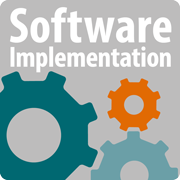
Software implementation is a systematically structured approach to effectively integrate a software based service or component into the workflow of an organizational structure or an individual end-user.
Structured Programming
In the process of coding, the lines of code keep multiplying, thus, size of the software increases. Gradually, it becomes next to impossible to remember the flow of program. If one forgets how software and its underlying programs, files, procedures are constructed it then becomes very difficult to share, debug and modify the program.
Top-down analysis – A software is always made to perform some rational work. This rational work is known as problem in the software parlance. Thus it is very important that we understand how to solve the problem.
Modular Programming – While programming, the code is broken down into smaller group of instructions. These groups are known as modules, subprograms or subroutines. Modular programming based on the understanding of top-down analysis.
Structured Coding – In reference with top-down analysis, structured coding sub-divides the modules into further smaller units of code in the order of their execution.
Functional Programming
Functional programming is style of programming language, which uses the concepts of mathematical functions. A function in mathematics should always produce the same result on receiving the same argument. In procedural languages, the flow of the program runs through procedures, i.e. the control of program is transferred to the called procedure.
First class and High-order functions – These functions have capability to accept another function as argument or they return other functions as results.
Pure functions – These functions do not include destructive updates, that is, they do not affect any I/O or memory and if they are not in use, they can easily be removed without hampering the rest of the program.
Recursion – Recursion is a
Programming style
Programming style is set of coding rules followed by all the programmers to write the code. When multiple programmers work on the same software project, they frequently need to work with the program code written by some other developer.
Naming conventions – This section defines how to name functions, variables, constants and global variables.
Indenting – This is the space left at the beginning of line, usually 2-8 whitespace or single tab.
Whitespace – It is generally omitted at the end of line.
Operators – Defines the rules of writing mathematical, assignment and logical operators.
Software Documentation
Software documentation is an important part of software process. A well written document provides a great tool and means of information repository necessary to know about software process.
Software Implementation Challenges
There are some challenges faced by the development team while implementing the software.
Code-reuse – Programming interfaces of present-day languages are very sophisticated and are equipped huge library functions. Still, to bring the cost down of end product, the organization management prefers to re-use the code, which was created earlier for some other software.
Version Management – Every time a new software is issued to the customer, developers have to maintain version and configuration related documentation.
Target-Host – The software program, which is being developed in the organization, needs to be designed for host machines at the customers end.
info: https://www.tutorialspoint.com/software_engineering/software_implementation.htm
Image: http://www.systec-services.com/software-implementation/
